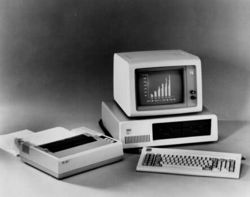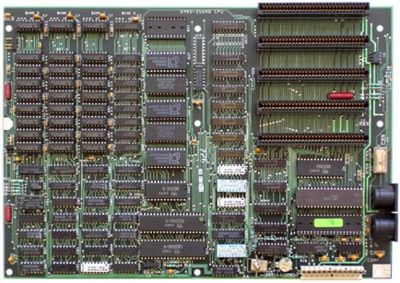Difference between revisions of "IBM 5150"
ForOldHack (talk | contribs) (→Added memory capacaties, as well as information on the ROM chips.) |
ForOldHack (talk | contribs) (→See also) |
||
| Line 31: | Line 31: | ||
* [[IBM-compatible PC]] | * [[IBM-compatible PC]] | ||
| + | * [[https://twitter.com/nixcraft/status/743144212569350148 Original IBM PC 5150 Prototype ]] | ||
| + | * [[https://archive.org/details/bitsavers_ibmpcpc150renceApr83_25494749 IBM PC Technical Reference BIOS Listings]] | ||
| + | |||
| + | See Appendix A: ROM BIOS Listings Pg A-1 | ||
[[Category: IBM PCs]] | [[Category: IBM PCs]] | ||
Revision as of 09:20, 28 March 2019
| IBM 5150/IBM PC | |
 The IBM PC | |
| Manufacturer: | International Business Machines |
|---|---|
| Year Introduced: | 1981 |
| Word Size: | 16 bit |
The IBM 5150 was IBM's entry into the personal computer marketplace; the IBM PC. It was introduced in stores on 1981-08-12.
The original configuration had a motherboard with 16K built in, designed for up to 64KB of RAM, and a cassette tape drive, but could be expanded to include a diskette drive, and a hard disk.
At the beginning they were advertised for around $1,600 for a unit with just 16KB of RAM and a keyboard[1]. Retail would be around $1,000 though[2], or maybe more likely in the $1,300 - $1,400 range[3]).
In practice you would add a at least a video adapter, probably some RAM, and a floppy disk drive. Then the price would be quite different. Back then, both types of disk drives were of the 5 1/4" full height form factor, single sided or double sided.
IBM made the PC an open standard, publishing not only schematics, but also including a BIOS listing in the technical reference. When people wished to build clones of the IBM PC, IBM would license them for a 5% royalty fee, which not only made the PC a popular platform to clone, but also with the available schematics, allowed for everyone to be pin compatible with the ISA slots, creating a thriving hardware expansion business.
The IBM PC included Microsoft BASIC in ROM, called Cassette Basic, which allowed the PC to function like many of the computers of the time with a simple ROM BASIC. With the addition of a disk drive, OS options included CP/M-86 and MS-DOS 1.0, and later MS-DOS 1.1 at the time of sale. DOS included a simple version of BASIC, known as disk BASIC, and a graphics version known as Advanced BASIC (BASICA.COM)
The IBM PC, also established the 8 bit expansion slot, or ISA bus standard as it was later called.
The PC started the IBM PC line; it was replaced by the wildly popular IBM XT, adding 3 more slots, and support for more memory on the motherboard ( 64k, expandable to 256k ).
The picture shows 5 ROMS, one was the ROM BIOS, and the other 4 were cassette BASIC.
See also
See Appendix A: ROM BIOS Listings Pg A-1
